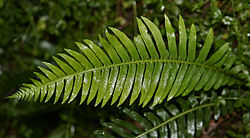Embryophyte
20.21
Diposting oleh zakky amarullah
| Land plants Fossil range: Late Silurian–Recent[1][2] (Spores from Ordovician) PreЄ Є O S D C P T J K Pg N | |
|---|---|
 | |
| Fern Leaf | |
| Scientific classification | |
| Kingdom: | Plantae |
| Subkingdom: | Embryophyta |
| Divisions | |
| |
The embryophytes (clade Embryophyta or Metaphyta) are the most familiar group of plants. They are often called land plants because they live primarily in terrestrial habitats, in contrast with the related green algae that are primarily aquatic. The embryophytes include trees, flowers, ferns, mosses, and various other green land plants. All are complex multicellular eukaryotes with specialized reproductive organs. With very few exceptions, embryophytes obtain their energy through photosynthesis (that is, by absorbing light); and they synthesize their food from carbon dioxide.
Diversity and classification
Embryophytes developed from complex green algae (Chlorophyta) during the Paleozoic era. The Charales or stoneworts appear to be the best living illustration of that developmental step.
Embryophyta may be distinguished from chlorophyll-using multicellular algae by having sterile tissue within the reproductive organs. Furthermore, embryophytes are primarily adapted for life on land, although some are secondarily aquatic. Accordingly, they are often called land plants or terrestrial plants.
The embryophytes also differ from algae in having metamers. Metamers are repeated units of development, in which each unit derives from a single cell, but the resulting product tissue or part is largely the same for each cell. The whole organism is thus constructed from similar, repeating parts or metamers. Accordingly, these plants are sometimes termed metaphytes and classified as the group Metaphyta.[3]
Bryophytes
In the first embryophytes, however, the sporophytes became very different in structure and function, remaining small and dependent on the parent for their entire brief life. Such plants are informally called 'bryophytes'. They include three surviving groups:
- Bryophyta (mosses)
- Anthocerotophyta (hornworts)
- Marchantiophyta (liverworts)
All of the above 'bryophytes' are relatively small and are usually confined to moist environments, relying on water to disperse their spores.
Vascular plants/Tracheophyta
Other plants, better adapted to terrestrial conditions, appeared during the Silurian period. During the Devonian period, they diversified and spread to many different land environments, becoming the vascular plants or tracheophytes. Tracheophyta have vascular tissues or tracheids, which transport water throughout the body, and an outer layer or cuticle that resists drying out. In most vascular plants, the sporophyte is the dominant individual, and develops true leaves, stems, and roots, while the gametophyte remains very small.
Many vascular plants, however, still disperse using spores. They include two extant groups:
- Lycopodiophyta (clubmosses)
- Pteridophyta (ferns, whisk ferns, and horsetails)
Other groups, which first appeared towards the end of the Paleozoic era, reproduce using desiccation-resistant capsules called seeds. These groups are accordingly called spermatophytes or seed plants. In these forms, the gametophyte is completely reduced, taking the form of single-celled pollen and ova, while the sporophyte begins its life enclosed within the seed. Some seed plants may even survive in extremely arid conditions, unlike their more water-bound precursors. The seed plants include the following extant groups:
- Cycadophyta (cycads)
- Ginkgophyta (ginkgo)
- Pinophyta (conifers)
- Gnetophyta (gnetae)
- Magnoliophyta (flowering plants)
The first four groups are referred to as gymnosperms, since the embryonic sporophyte is not enclosed until after pollination. In contrast, among the flowering plants or angiosperms, the pollen has to grow a tube to penetrate the seed coat. Angiosperms were the last major group of plants to appear, developing from gymnosperms during the Jurassic period, and then spreading rapidly during the Cretaceous. They are the predominant group of plants in most terrestrial biomes today.
Relationship to green algae
Note that the higher-level classification of plants varies considerably. Some authors have restricted the kingdom Plantae to include only embryophytes, others have given them various names and ranks. The groups listed here are often considered divisions or phyla, but have also been treated as classes, and they are occasionally compressed into as few as two divisions. Some classifications, indeed, consider the term Embryophyta at the superphylum (superdivision) level, and include Land Plants and some Charophyceae in a subkingdom named Streptophyta.
On a microscopic level, embryophyte cells remain very similar to those of green algae. They are eukaryotic, with a cell wall composed of cellulose and plastids surrounded by two membranes. These usually take the form of chloroplasts, which conduct photosynthesis and store food in the form of starch, and characteristically are pigmented with chlorophylls a and b, generally giving them a bright green color. Embryophytes also generally have an enlarged central vacuole or tonoplast, which maintains cell turgor and keeps the plant rigid. They lack flagella and centrioles except in certain gametes.
Posting Komentar